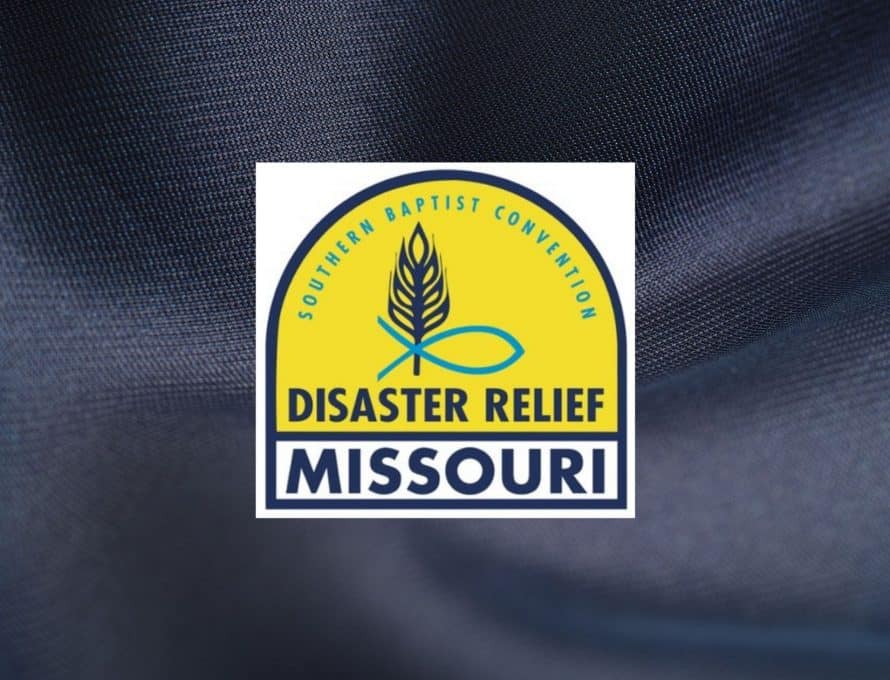JEFFERSON CITY – When Gaylon Moss is asked why people should be involved in Missouri Baptist Disaster Relief (MODR), he is always quick to point people to the ministry’s key vision statement: “Transforming lives and communities with the gospel by bringing help, hope and healing.”
He is passionate about disaster relief (DR) ministry and was pleased to share that 20 persons asked Jesus Christ to be their Lord and Savior this past year through MODR.
The group responded to 17 incidents in Missouri, the nation and across the world. There were several other “local responses” by associational and church DR teams in Missouri.
There are about 2,000 trained MODR volunteers who hold credentials and certifications in the various aspects of DR ministry, Moss said.
This past year those volunteers logged in 3,681 volunteer days as of December 1. They prepared over 45,000 hot meals and completed 700 recovery jobs (ash-out, flood recovery and chainsaw ministry).
Asked if a person has to be certified in MODR ministry to serve, Moss said they do want people to be trained, but in most DR call-outs a person can come along with a MODR team and work alongside and under the supervision of trained volunteers. They hope they will be inspired to then go the next training session and get credentials. He added that there are some high profile disasters which have high security zones and only credentialed DR volunteers are allowed in the area so it is to the advantage of the volunteer to be trained in advance.
He said “Please do not self deploy or show up ‘spontaneously.” Volunteers in a disaster are best managed when they are in a group with training, supervision and accountability.
The MODR has a vocabulary of terms that may be confusing at first. Moss defined some of those terms for those getting familiar with the ministry.
Disaster Relief in Missouri is also called MODR for short. It is part of a national network of state convention disaster relief teams called Southern Baptist Disaster Relief.
DR ministry was founded in Texas with Royal Ambassador groups who were able to respond with small “buddy burner” meal cooking stoves when a tornado roared through a community near where the Royal Ambassadors (a boy’s mission education group) was having a campout. Buddy burners are gallon food cans with holes punched out in the sides and turned over with a sterno burner under them to create a makeshift stove for cooking food. One of the Royal Ambassadors (RA’s) leaders was able to quickly respond to the tornado and cook some food for the tornado survivors.
Gold and blue are the DR colors as a result of the ministry’s ties to their Royal Ambassador heritage which also features those colors. Gold represents the worth of every person to Christ. The blue represents our loyalty to Christ.
So the color of most MODR volunteers shirts and hats is gold (some say yellow but the correct term is gold). These volunteers are the primary workforce of the MODR ministries. They are commonly called “gold hats.”
They are led by “blue hats” who are team leaders of a unit. These supervisors coordinate to make sure there are sufficient jobs available for the volunteers and safety precautions in place.
The incident commanders are called “white hats” and they are responsible for the incident management team (IMT). This team manages overall operations and effectiveness at an incident. They are often based in a church building near a disaster where volunteers are working and they help the process work smoothly.
Moss said there are representatives of the following DR ministries on the IMT team: chaplains, liason, safety, public information and the incident command officer. They are supplemented by operations, planning, logistics and administration chiefs.
The types of specific ministries that a DR team may engage in will include:
• Mass Feeding (also called mobile kitchen or feeding units). They prepare large amounts of food in a disaster incident, sometimes several thousand meals a day.
• Recovery which includes flood recovery, fire recovery and chainsaw units). Flood recovery units are sometimes called “mud out” units and the volunteers help clean up flood damage by taking out walls up to a point beyond the water damage and sanitizing the studs so they may be replaced later. They clean out basements and carry out damaged goods from the homes.
• Fire recovery is ministry following wildfires where volunteers sift though ashes of a residential fire and help prepare the site for a rebuilding effort later.
• Chain Saw Recovery units operate in the aftermath of tornadoes and hurricanes clearing downed trees and limbs and helping homeowners get debris removed from their property.
• Child Care ministry is offered to care for children in safe and secure locations for disaster survivors as they recover from an incident.
• Shower/Laundry units provide shower trailers and portable laundry facilities.
• Chaplains go into disaster zones and provide listening ears, encouragement, Scripture and counsel as they help people adjust to a “new normal” following an incident.
There is a careful effort not to refer to people as “victims” of a disaster bur rather a more positive perspective of calling them “survivors,” Moss added.
He concluded by saying “The Lord cares for people in need. I am thankful that He uses MODR to provide for disaster survivors. Some people are saved through church services, friends, music ministries, etc. But sometimes it takes a disaster to show them the light of Jesus Christ.”
For more information on becoming involved in or contributing to disaster relief ministry check the group’s website at www.modr.org.

